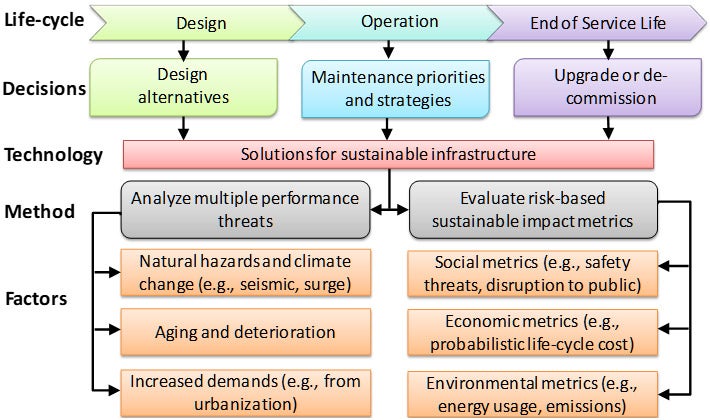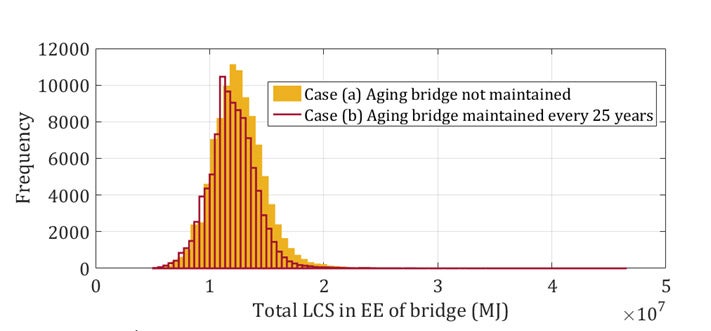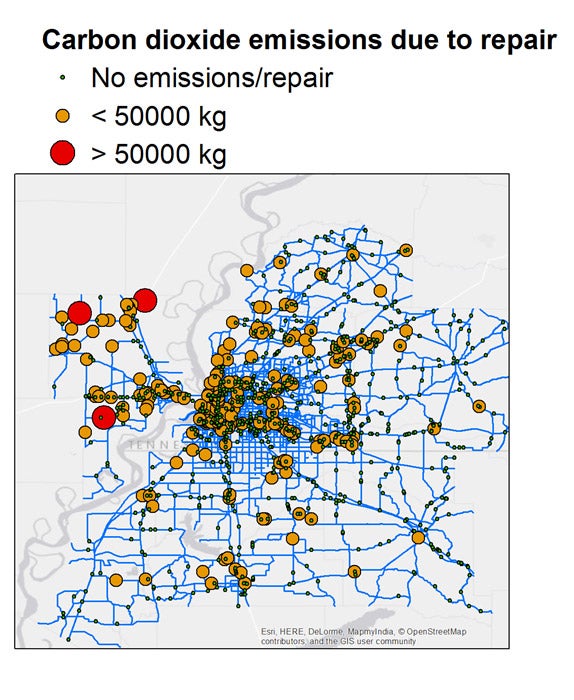Sustainability and Life-Cycle Analysis
Infrastructure faces multiple threats, including aging and deterioration, increased demand by a growing population, and natural hazards that may become more frequent with climate change. These threats result not only in physical damage, but cascading social, environmental, and economic impacts that impair sustainability. Work in the Padgett Research Group provides to strategies to quantify and promote sustainable built infrastructure that effectively serves public needs while limiting any adverse environmental, social and economic impacts. Our work offers life-cycle analyses frameworks for probabilistic assessment of sustainability indicators incurred throughout a system’s life-time, along with input tools and insights from application to various systems. For example, in the SSIMT model, “Sustainable Solutions for Bridge Infrastructure Subjected to Multiple Threats,” performance goals for bridges are driven by sustainability metrics, such as energy usage, life-cycle cost, and downtime, while ensuring safety.

A) Infrastructure Life-Cycle Sustainability Analysis (LCS-A)
Description: Our work has proposed and advanced a life-cycle sustainability analysis (LCS-A) framework to quantify sustainability of infrastructure systems. Multiple life-cycle phases, or stages, of interest are considered ranging from initial construction through operation and demolition. Key aspects of the framework include the ability to capture multiple threats and phase interactions, propagate and test significance of uncertainties from a range of sources, more accurately capture post-repair performance, among other features. As a part of this effort, vulnerability models are developed or leveraged to uncover the complex coupled effects of natural hazards, aging and deterioration, and increased demands on bridge reliability. This physical vulnerability is related to metrics of sustainable performance for specific social, environmental, and economic impacts, ranging from safety to downtime, and from life-cycle cost to energy usage. Analytical risk-based methods are formulated to evaluate and select investment strategies that simultaneously mitigate threats while promoting sustainability. The viability of alternative stochastic process models, analytical formulations, model assumptions, and parameter sensitivities are explored as a part of ongoing and future work.

B) Sustainability Evaluations at the Structural System Level
Description: The LCS-A framework has been developed and adapted through research in the Padgett Research Group to structural system level quantification of sustainability, particularly for applications to bridge systems. Our research develops appropriate input tools, such as parameterized fragilities for time dependent analysis of bridge vulnerability to hazards, such as earthquakes, and service loads, like truck traffic. Life-cycle phase interactions are explored, such as the impact of bridge maintenance not only on service load reliability but also on hazard vulnerability, and probabilistic sensitivity analyses conducted to reveal the relative importance of uncertainties stemming from different life-cycle phases including material, labor costs as well as bridge parameters. The distribution of various sustainability indicators (e.g. embodied energy, EE) for each life-cycle phase as well as total LCS-A are derived, and insights on the impact of maintenance, retrofit or improved data collection offer practical insight for analysts and owners.

C) Network Level Sustainability Quantification
Description: Our work also pursues sustainability evaluation at the regional infrastructure network level, particularly for transportation infrastructure. For example, highway network sustainability is quantified on the basis of: (a) bridge or roadway level investments and repairs required (see image) along with (b) network level impacts associated with traffic congestion or disruption. The consideration of multiple threats allows exploration of the sustainability risk profile of infrastructure networks, such as the relative risk of exceeding target emissions limits due to expenditures attributed to natural hazard exposure or to overweight vehicles. As pursued in ongoing research, these sustainability evaluations can guide the management and design of infrastructure systems to achieve broader sustainability objectives for a region.

